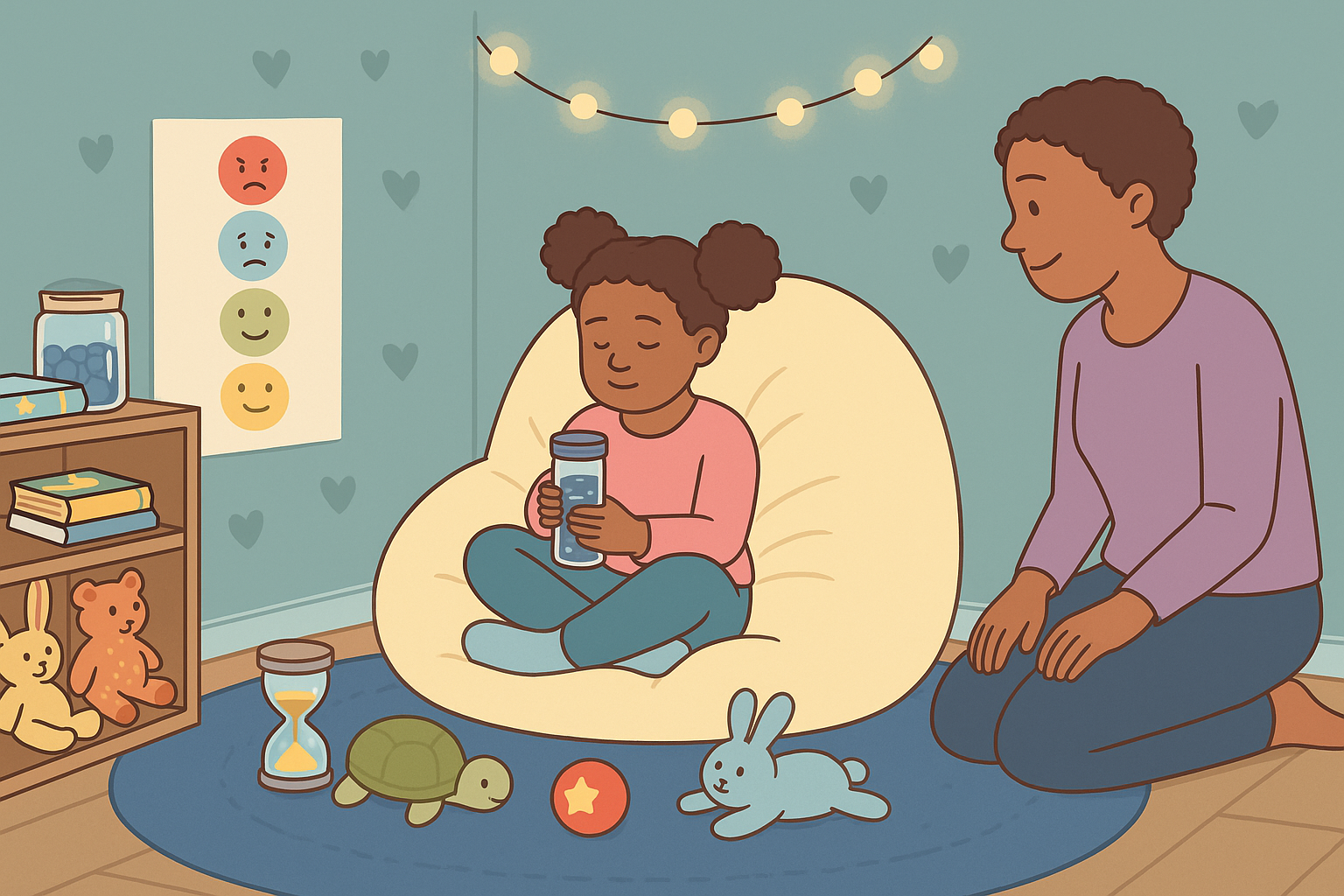Building a Calm-Down Corner That Actually Works
Building a Calm-Down Corner That Actually Works
When kids melt down, yell, or throw things, sending them away to “think about it” doesn’t teach calm — it teaches isolation. A calm-down corner flips that script.
It’s not a timeout zone — it’s a regulation zone, a safe space where children learn to recognize big feelings and use tools to return to calm. Done right, it becomes one of the most powerful discipline tools in your home.
Why Calm-Down Corners Work
When a child is overwhelmed, their logical brain shuts down. They need to co-regulate first — to feel safe, seen, and supported — before they can self-regulate.
A calm-down corner helps kids:
Recognize emotional signals
Access tools to soothe
Build independence in managing stress
✨ You’re not sending them away — you’re inviting them into peace.
👉 See also: Staying Calm When Your Child Won’t
1. Choose the Right Location
Pick a quiet, cozy spot away from distractions and high traffic.
Best places:
A corner of the living room or bedroom
Beside a window with soft light
A reading nook or tented area
Avoid:
Isolated rooms or closed doors (kids need connection, not exile)
✨ Calm is built through safety, not solitude.
Skill focus: environment design, safety, emotional regulation
2. Name It Something Positive
Avoid “timeout” or “naughty” labels. Call it the “peace corner,” “cozy spot,” or “feel-better place.”
You can even let your child choose the name — ownership increases willingness to use it.
✨ Language sets the tone for calm instead of shame.
Skill focus: emotional association, choice, cooperation
3. Add Soothing Sensory Tools
Stock the space with calm-down helpers that engage the senses and body.
Ideas:
Soft stuffed animals or blankets
Squishy stress balls or sensory putty
Picture books about feelings
Calm-down bottles (glitter jars)
Headphones or white-noise machine
Calm breathing cards or emotion charts
✨ Sensory regulation comes before emotional regulation.
Skill focus: self-soothing, sensory awareness, mindfulness
4. Teach How and When to Use It
Introduce the calm-down corner when everyone’s calm — not mid-meltdown.
Show how to use it:
Model sitting down and breathing slowly.
Practice choosing a tool (like a fidget or stuffed animal).
Explain that it’s a place to feel better, not get in trouble.
✨ Kids can’t use a tool they haven’t rehearsed.
Skill focus: emotional literacy, modeling, self-control
5. Stay Nearby During Early Use
At first, children will need your co-regulation. Sit close, breathe with them, or quietly offer support.
Say:
“You’re feeling angry. I’ll stay with you while you calm your body.”
“You can choose your breathing card or hug your bear.”
✨ Calm is contagious — especially yours.
Skill focus: co-regulation, connection, empathy
👉 See also: When Kids Test Boundaries on Purpose
6. Personalize the Space
Invite your child to help decorate it.
Draw posters of emotions (“mad,” “sad,” “calm”)
Add photos or drawings that make them smile
Let them pick a special calming object
✨ Ownership turns discipline into empowerment.
Skill focus: creativity, autonomy, emotional safety
7. Use It Consistently — Not as Punishment
The calm-down corner should be offered regularly, not only in crises.
Say:
“Looks like your body needs a calm-down break.”
“Let’s go to the cozy corner together.”
Avoid:
“Go to the calm-down spot until you behave!”
✨ Consistency teaches choice, not control.
Skill focus: trust, predictability, emotional balance
8. Reflect After Calm Returns
Once your child is regulated, gently review what happened.
Ask:
“What feeling did you notice?”
“What helped you calm down?”
“What could we try next time?”
✨ Reflection turns self-soothing into self-awareness.
Skill focus: reflection, emotional intelligence, growth
Key Takeaways
A calm-down corner builds emotional regulation, not punishment.
Choose a safe, sensory-friendly space and teach its use proactively.
Co-regulate early; independence comes later.
Reflection after calm cements learning.
A calm-down corner isn’t a timeout — it’s a tool for emotional growth. When kids learn that calm is something they can find, not something that happens to them, they begin to master one of life’s most powerful skills: self-regulation.
You’re not removing them from the problem — you’re teaching them to manage it.
This content is for educational purposes and is not a substitute for professional medical or psychological advice.
Popular Parenting Articles


